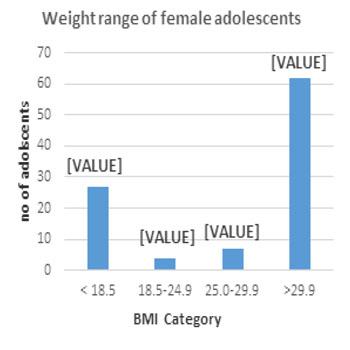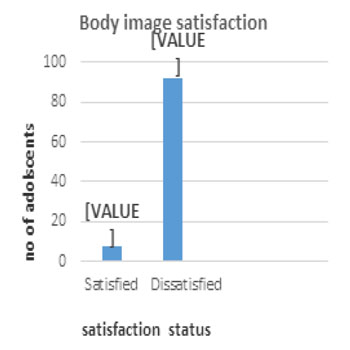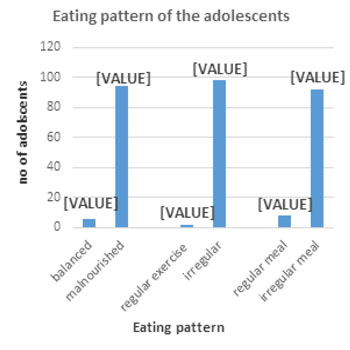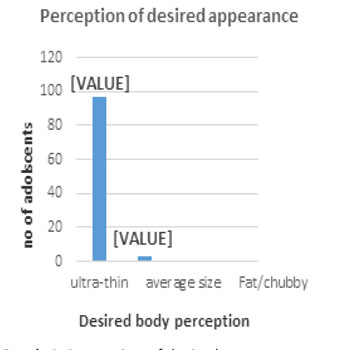Previous Issues Volume 2, Issue 1 - 2017
Body Image and Weight Concern among Pakistani Adolescent Females
Nida Tabassum Khan*, Jibran Jameel, Maham Jameel Khan, Saad Umer Abdul Rehman, Namra Jameel
Department of Biotechnology, Faculty of Life Sciences and Informatics, Balochistan University of Information Technology Engineering and Management Sciences, Quetta, Pakistan.
Corresponding Author: Nida Tabassum Khan, Department of Biotechnology, Faculty of Life Sciences and Informatics, Balochistan University of Information Technology Engineering and Management Sciences, Quetta, Pakistan, Tel: 92 81 111 717 111; E-Mail: [email protected]
Received Date: 04 Mar 2017
Accepted Date: 23 Mar 2017
Published Date: 27 Mar 2017
Copyright © 2017 Khan NT
Citation: Khan NT, Jameel J, Khan MJ, Rehaman SUA, et al. (2017). Body Image and Weight Concern among Pakistani Adolescent Females. Mathews J Dermatol. 2(1): 011.
ABSTRACT
Body image is usually measured in terms of weight status of an individual revealing its association with body satisfaction status. It has been observed in numerous cultural communities that a direct relationship between weight status and body dissatisfaction begins to develop in children entering puberty. This study was conducted among the female adolescents of Islamia Girls College Quetta. The participants included in this study were selected randomly keeping the sample size 100. Study was conducted with the help of a self-developed validated questionnaire and measured BMI category to find association between weight status and body dissatisfaction. Obtained results revealed that a high percentage of female adolescents were obese (62%) and (27%) were under the category of underweight because of their mal adaptive eating patterns leading to increased level of body dissatisfaction and also because of high levels of internalization and social comparison.
Keywords
BMI; Weight; Adolescent; Pakistani.
INTRODUCTION
Schilder defined body appearance as a psychosocial aspect in which an individual forms a picture of his or her body in the mind [1]. Body image influence many features of human behaviour such as feelings emotions, mindset, relationships etc. Therefore, effects of body image on an individuals personality is prominent and extensive [2]. Body image is usually measured in terms of weight status of an individual revealing its association with body satisfaction status. It has been observed in numerous cultural communities that a direct link between weight status and body dissatisfaction begins to develop in children entering puberty [3-14]. Body image is perceived on the basis of individuals weight whether he or she is underweight, over or obese and usually a fat body has been discouraged or criticized among adolescent [15-17]. A number of studies confirmed that overweight or obese adolescence indicates high levels of body dissatisfaction in both sexes [8, 11, 18-21]. There may be a number of sociocultural and physical factors such as malnourished diet, decreased exercise and unhealthy weight control responsible for weight gain in adolescents leading to body dissatisfaction [22-25]. Due to lack of reliability in measurement scales, we face a number of limitations in terms of socio-cultural background of the studied participants in investigating body image and body dissatisfaction relationship. Presently in Pakistan there is insufficient understanding and scarce literature available about how and when exactly weight concern is established in female adolescents. Therefore in this study we aimed to describe body image size perception among Pakistani adolescent females and its affiliation with weight status.
MATERIALS AND METHODS
Adolescent female students of Islamia Girls College Quetta was included in this study. Informed consent was obtained from these students selected at random keeping the sample size 100. Study was conducted with the help of a self-developed validated questionnaire designed to find information about eating patterns of individual participants and their perception regarding their body image. BMIs of the individuals were calculated. Adolescents were also categorized as normal, under/overweight and obese. Statistical analysis of the data was done by means of Microsoft excel.
RESULTS
Out of 100 adolescents females, 62% was obese while 27% was underweight out of the total n= 100 as shown in (Table 1) and (Graph 1).
Table 1: Weight Range of Female Adolescents.
| S.no | category | Weight range | (n=100) |
|---|---|---|---|
| 1 | < 18.5 | Under weight | 27 |
| 2 | 18.5-24.9 | Normal | 4 |
| 3 | 25.0-29.9 | Over weight | 7 |
| 4 | >29.9 | Obese | 62 |
Graph 1: Weight range of female adolescents based on their BMI category.
92% of teenagers were not satisfied with their body image while a very low percentage (8%) of females were satisfied with their body as indicated in (Table 2) and (Graph 2).
Table 2: Body Image Satisfaction of Adolescents
.
| S.no | Body image satisfaction status | No of adolescent (%) (n=100) |
|---|---|---|
| 1 | Satisfied | 8 |
| 2 | Dissatisfied | 92 |
Graph 2: Body image satisfaction status of adolescents.
Eating patterns of 100 adolescents were given in (Table 3) and (Graph 3).
Table 3: Eating Pattern of the Adolescents.
| S.no | Eating pattern | No of adolescent (n=100) |
|---|---|---|
| 1 | Diet plan | |
| Balanced | 6 | |
| Malnourished | 94 | |
| 2 | Exercise | |
| Regular | 2 | |
| Irregular/none | 98 | |
| 3 | Meal times | |
| Regular three times a day | 8 | |
| Irregular i.e. skipping meals | 92 |
Graph 3: Eating Pattern of the Adolescents.
Perception of desired appearance among the 100 adolescents is given in (Table 4) and (Graph 4).
Table 4: Perception of Desired Appearance among Adolescents.
| S.no | Perception of desired appearance | |
|---|---|---|
| 1 | Ultra-thin | 97 |
| 2 | Average sized | 3 |
| 3 | Fat /chubby | 0 |
Graph 4: Perception of desired appearance.
DISCUSSION
Unsurprisingly, we found a high percentage of female adolescents to be obese (62%) and (27%) to be underweight. A very small proportion of adolescents were found to be under the category of normal and overweight as indicated in (Table 1).The reason for this increased weight status is associated with their relative eating patterns as (Table 3) clearly depicted that a large percentage of these females were on a diet and were found to be malnourished and does not fulfil their daily nutritional requirements as a result either these Pakistani adolescents were underweight or obese. No exercise followed by irregular meal times also contribute towards their rapid weight gain and loss. Factors such as cultural norms, media influences, and religious practices may also be held accountable for their weight status. Currently very little have been discovered regarding increasing weight associated body dissatisfaction among Pakistani adolescents in the past. Our findings indicates that high rate of body dissatisfaction (92%) is associated with body image perception. Particularly during this phase of growth, adolescents develops self-awareness about their body size or physical appearance which ultimately effects their attitude towards their body size. As it is apparent that underweight and obese adolescent females appear to suffer from body dissatisfaction. Besides, societal norms executed through media, magazines, TV, films, advertisements etc. underlines that female self-esteem is merely based on their physical appearance and reflects a prevailing image of female beauty [28, 29]. For example according to a study it was reported that almost 76% of female characters in television sitcoms were below normal weight [30] that is often more than 20% underweight [31]. Unrealistic media images created through, digital alteration, concealing and surgery were adopted as standards for women self-evaluation [32]. Therefore in such circumstances it is important to establish early interventions to aid adolescent females to recognize and distinguish between a realistic and unrealistic body images [33]. 97% of the adolescents desired to have ultra-thin body size as shown in (Table 4). Thus, it comes as no great surprise that adolescent girls believed that magazine pictures influenced their idea of ideal body shape, and wished to lose weight as a result [34]. Public assessment may be an important mechanism for adverse effects of the media on womens body image. As studies reported that as soon as attractive media models are presented it triggers comparison automatically for women [35, 36]. However there were number of limitations in this study such as participants were mostly middle-class, and all were attending a single-sex college etc. but still the obtained results could be fruitful on giving adolescents tools to deconstruct the so called ideal body mentality.
CONCLUSION
Data from this study revealed that adolescent girls perceptions of their attractiveness may be attributable to increasing social comparison with media models. Awareness of body image size and increasing body dissatisfaction with higher weight status is established among adolescent females in this population. Therefore requires interventions to reduce concerns regarding weight status to achieve an ideal body which does not exists.
REFERENCES
- Schilder PM. (1978). The image and appearance of the human body: studies in the constructive energies of the psyche. New York: International Universities Press.
- Cash TF and Pruzinsky T. (2002). Understanding body images: historical and contemporary perspectives. Body image: a handbook of theory, research & clinical practice. New York: The Guilford Press. 3-12.
- Lee K, Sohn H, Lee S and Lee J. (2004). Weight and BMI over 6 years in Korean children: relationships to body image and weight loss efforts. 12(12): 1959-1966.
- Rinderknecht K and Smith C. (2002). Body-image perceptions among urban native American youth. 10(5): 315- 327.
- Ozmen D, Ozmen E, Ergin D, Cetinkaya AC, et al. (2007). The association of self-esteem, depression and body satisfaction with obesity among Turkish adolescents. BMC Public Health. 7: 80.
- Crow S, Eisenberg ME, Story M and Neumark-Sztainer D. (2006). Psychosocial and behavioural correlates of dieting among overweight and non-overweight adolescents. J Adolesc Health. 38(5): 569-574.
- Mirza NM, Davis D and Yanovski JA. (2005). Body dissatisfaction, self-esteem, and overweight among inner-city Hispanic children and adolescents. J Adolesc Health. 36(3): e16-e20.
- Newman DL, Sontag LM and Salvato R. (2006). Psychosocial aspects of body mass and body image among rural American Indian adolescents. J Youth Adolesc. 35: 281-291.
- Duncan MJ, Al-Nakeeb Y, Nevill AM and Jones MV. (2006). Body dissatisfaction, body fat and physical activity in British children. Int J Pediatr Obes. 1(2): 89-95.
- Ricciardelli LA, McCabe MP, Holt KE, Finemore J, et al. (2003). A biopsychosocial model for understanding body image and body change strategies among children. Appl Dev Psychol. 24(4): 475-495.
- Ricciardelli LA, McCabe MP, Lillis J and Thomas K. (2006). A longitudinal investigation of the development of weight and muscle concerns among preadolescent boys. J Youth Adolesc. 35: 168.
- Robinson TN, Chang JY, Haydel KF and Killen JD. (2001). Overweight concerns and body dissatisfaction among third-grade children: the impacts of ethnicity and socioeconomic status. J Pediatr. 138(2): 181-187.
- Yates A, Edman J and Aruguete M. (2004). Ethnic differences in BMI and body/self-dissatisfaction among whites, Asian subgroups, Pacific Islanders, and African-Americans. J Adolesc Health. 34(4): 300-307.
- Davison KK, Markey CN and Birch LL. (2000). Etiology of body dissatisfaction and weight concerns among 5-yearold girls. Appetite. 35(2): 143-151.
- Musher-Eizenman DR, Holub SC, Edwards-Leeper L, Persson AV, et al. (2003). The narrow range of acceptable body types of preschoolers and their mothers. Appl Dev Psychol. 24(2): 259-272.
- Ricciardelli LA and McCabe MP. (2001). Childrens body image concerns and eating disturbance: a review of the literature. Clin Psychol Rev. 21: 325-344.
- Smolak L. (2004). Body image in children and adolescents: where do we go from here?. Body Image. 1(1): 15-28.
- Shunk JA and Birch LL. (2004). Girls at risk of overweight at age 5 are at risk for dietary restraint, disinhibited overeating, weight concerns, and greater weight gain from 5 to 9 years. J Am Diet Assoc. 104(7): 1120-1126.
- Mertens M and Vandereycken W. (1998). History of prepubertal overweight in adolescent girls with pronounced body dissatisfaction. Eat Disord. 6(3): 225-229.
- McCabe MP and Ricciardelli LA. (2005). A longitudinal study of body image and strategies to lose weight and increase muscles among children. Appl Dev Psychol. 26: 559-577.
- Wardle J, Waller J and Fox E. (2002). Age of onset and body dissatisfaction in obesity. Addict Behavs. 27(4): 561-573.
- Haines J, Neumark-Sztainer D, Wall M and Story M. (2007). Personal, behavioural, and environmental risk and protective factors for adolescent overweight. Obesity. 15(11): 2748-2760.
- Van den Berg P and Neumark-Sztainer D. (2007). Fat n happy 5 years later: is it bad for overweight girls to like their bodies?. J Adolesc Health. 41(4): 415-417.
- Neumark-Sztainer D, Paxton SJ, Hannan PJ, Haines J, et al. (2006). Does body satisfaction matter? Five-year longitudinal associations between body satisfaction and health behaviors in adolescent females and males. J Adolesc Health. 39(2): 244-251.
- Davison KK, Markey CN and Birch LL. (2003). A longitudinal examination of patterns in girls weight concerns and body dissatisfaction from ages 5 to 9 years. Int J Eat Disord. 33(3): 320-332.
- Padgett J and Biro FM. (2003). Different shapes in different cultures: body dissatisfaction, overweight, and obesity in African-American and caucasian females. J Pediatr Adolesc Gynecol. 16(6): 349-354.
- Davison KK, Markey CN and Birch LL. (2000). Etiology of body dissatisfaction and weight concerns among 5-yearold girls. Appetite. 35(2): 143-151.
- Richins ML. (1991). Social comparison and the idealized images of advertising. Journal of Consumer Research. 18(1): 71-83.
- Silverstein B, Perdue L, Peterson B and Kelly E. (1986). The role of mass media in promoting a thin standard of bodily attractiveness for women. Sex Roles. 14: 519-532.
- Fouts G and Burggraf K. (2000). Television situation comedies: Female weight, male negative comments and audience reactions. Sex Roles. 42(9): 925-935.
- Spitzer BL, Henderson KA and Zivian MT. (1999). Gender differences in population versus media body sizes: A comparison over four decades. Sex Roles. 40 (7): 545-565.
- Thompson JK, Heinberg LJ, Altabe M and Tantleff-Dunn S. (1999). Exacting beauty: Theory, assessment and treatment of body image disturbance. Washington, DC: American Psychological Association.
- Attie I and Brooks-Gunn J. (1989). Development of eating problems in adolescent girls: A longitudinal study. Developmental Psychology. 25(1): 70-79.
- Field E, Cheung L, Wolf A, Herzog DB, et al. (1999). Exposure to the mass media and weight concerns among girls. American Academy of Pediatrics. 103(3).
- Cattarin JA, Thompson JK, Thomas C and Williams R. (2000). Body image, mood, and televised images of attractiveness: The role of social comparison. Journal of Social and Clinical Psychology. 19(2): 220-239.
- Dittmar H and Howard S. (2004). Ideal-body internalization and social comparison tendency as moderators of thin media models impact on womens body-focused anxiety. Journal of Social and Clinical Psychology. 23(6): 768-791.



